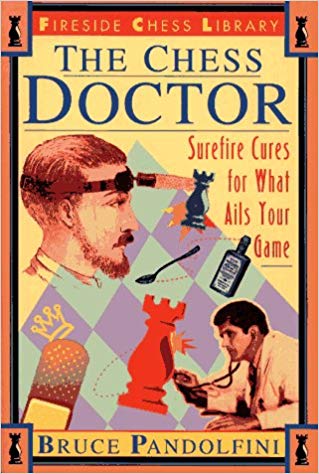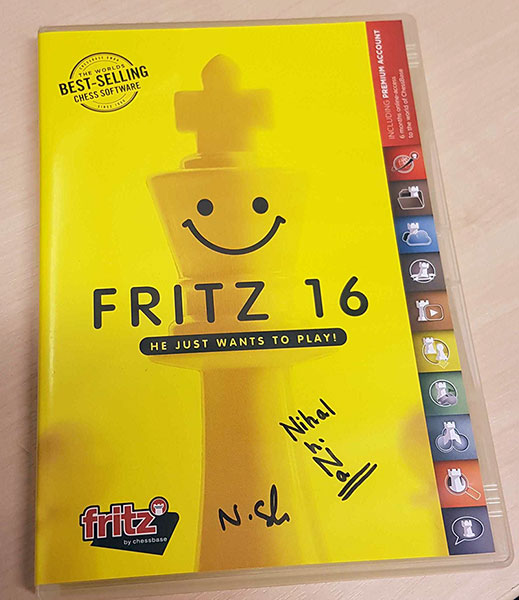


The Senior Director of Strategic Communication for US Chess, Daniel Lucas, can’t stand chess boards that are oriented incorrectly. This photo shows his scary Halloween costume, with a black square incorrectly located in the right-hand corner. Lucas also posts photos on Facebook of chess boards which are oriented correctly but upon which the kings and queens are reversed. That is, for example, a white king initially placed on d1 and a white queen placed on e1.
Such transgressions aggravate Lucas and other chess players and torpedo the chance to play a legal game. What follows are sayings that teach how to get the board oriented correctly and the kings and queens where they belong. For orienting the board correctly, say “White on the right,” meaning a white square at each player’s right hand. For placing the white queen on a white square (d1) and the black queen on a black square (d8) at the start of the game, say “Queen on her own colour.” Some chess teachers instead say “the queen’s dress matches her starting square because she likes to be fashionable.”
Many beginners like to play on the edges of the board, perhaps to avoid conflict. A common beginner opening is 1.h4 followed by 2.♖h3, which usually leads to the loss of an exchange (after a later …♝xh3 by Black). I wish I had a saying or a song to stop beginners from playing this disastrous opening.

There are sayings to discourage chess players from putting their knights far from the centre. Most notably, “a knight on the rim is grim” or “a knight on the rim is dim.” Both sayings mean don’t put your knights on the edge of the board. In the opening, White playing ♘h3 or ♘a3 is usually not as good as ♘f3 or ♘c3 and as Black playing ♞h6 or ♞a6 is usually not as good as ♞f6 or ♞c6.
One saying I share with my students is “Trade pieces when you are ahead, trade pawns when you are behind.” In his book The Chess Doctor, famed chess teacher Bruce Pandolfini gave the following application of the saying: Consider the case of a bishop and seven pawns versus a bishop and six pawns. Exchanging bishops may lead to a winning pawn ending. However, trading off many of the pawns may allow the defender to sacrifice his bishop for the remaining pawns, and then one cannot checkmate with just a bishop and king against a king.
Chess coach Dan Heisman’s website has many more sayings (principles) for the opening, middlegame, and endgame phases.
Like books and websites, videos share sayings. This video of IM Eric Rosen, explains his saying “7 heaven.” More commonly, that saying is “seventh heaven” or “pigs on the seventh” where “pigs” are same-color rooks.
A bit later, in the video (at 37:00 minutes), Rosen gives an example of “trade pieces when you are ahead, trade pawns when you are behind.”
In this position, as Rosen demonstrates, trading off both white rooks for both black rooks would lead to a black king and three pawns winning against a white king and two pawns. But trading off just one white rook for one black rook makes the ending a theoretical draw. In other words, Black (who is ahead in material) must trade off all the pieces (rooks) to win this particular game.
I recently wrote about a Facebook posting by the Director-General of FIDE, GM Emil Sutovsky. Sutovsky asked whether those who have studied chess could name, in order, the world champions from Steinitz to Kasparov. Several of those who replied to Sutovsky knew not just the names but also the results of world championship matches and which games were significant within those matches.
By itself, reciting the names of the world champions is not going to improve your chess skills. But knowing the names introduces you to chess history, so when someone mentions “Fischer” you don’t reply “Who is that?” And, when you have memorized the names of the world champions, you realize that Stan Vaughan is not one of them.
For memorizing the names of the world champions, you could listen to music. For example, part 2 of the song “Endgame” from the musical Chess begins with Steinitz and continues through Karpov.
Here are the dates and names provided by Endgame’s lyrics: “1886 Wilhelm Steinitz, 1894 Emanuel Lasker, 1921 José Capablanca, 1927 Alex Alekhine, 1935 Euwe, 1948 Mikhail Botvinnik, 1957 Vasily Smyslov, 1960 Tal, 1963 Tigran Petrosian, 1969 Boris Spassky, 1972 Bobby Fischer, 1975 Anatoly Karpov.” The first year each champion won his title is given before his name, and some first names are either shortened or missing.
There have been eight world champions since Karpov. Listing the years when they first won their titles: 1985 Garry Kasparov, 1999 Alexander Khalifman, 2000 (November) Vladimir Kramnik, 2000 (December) Viswanathan Anand, 2002 Ruslan Ponomariov, 2004 Rustam Kasimdzhanov, 2005 Veselin Topalov, and 2013 Magnus Carlsen.
For my birthday (July 24), I asked my son William, who teaches music at the Montessori Academy at Onesimo Hernandez Elementary, for a song that included all the world champions. William composed the song, set to the tune of Baa Baa Black Sheep/Twinkle, Twinkle, Little Star. My birthday came on the middle day of my five mornings of teaching chess at MOSAIC summer enrichment courses. The six children in my advanced chess course rehearsed William’s “World Champions” song for five minutes on Thursday, July 25, for another five minutes on Friday, and then they performed it. That July 26th performance was filmed by two MOSAIC journalism students.

William's sheet music for the song | CGA Mosaic Times blog
The chess course students’ performance would have been better with more rehearsal, but the song served its purpose of introducing the names of the world champions.
You may use it to learn or to teach the names of the world champions. Music helps me remember, and not just the names of chess world champions. I can recite the Preamble to the United States Constitution when this Schoolhouse Rock song plays in my head.
In the comments, please share your favourite chess saying or song. And if you have one that teaches beginners not to start with 1.h4, 2.♖h3 (or similar, such as 1…a5, 2…♜a6), I will borrow it.
As an added incentive, ChessBase will raffle off (among those commenting) a copy of Fritz 16 autographed by Indian chess prodigy GM Nihal Sarin and his coach Srinath Narayanan!
